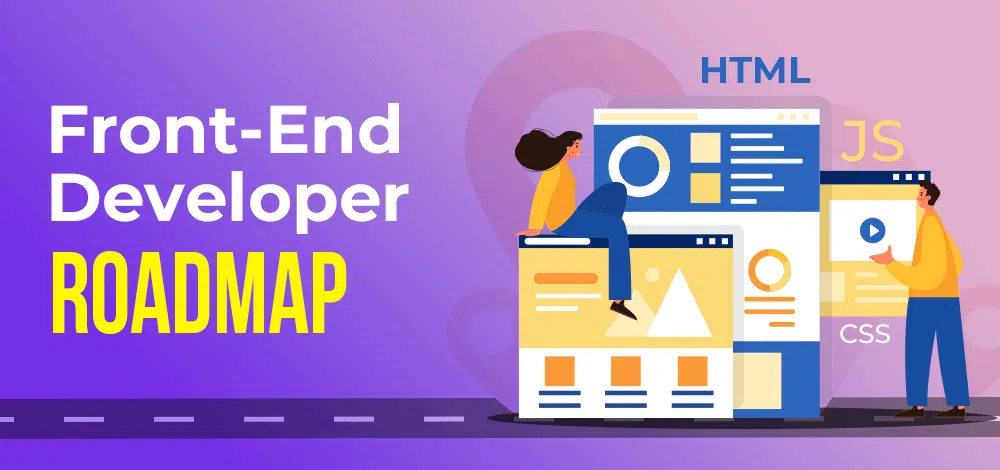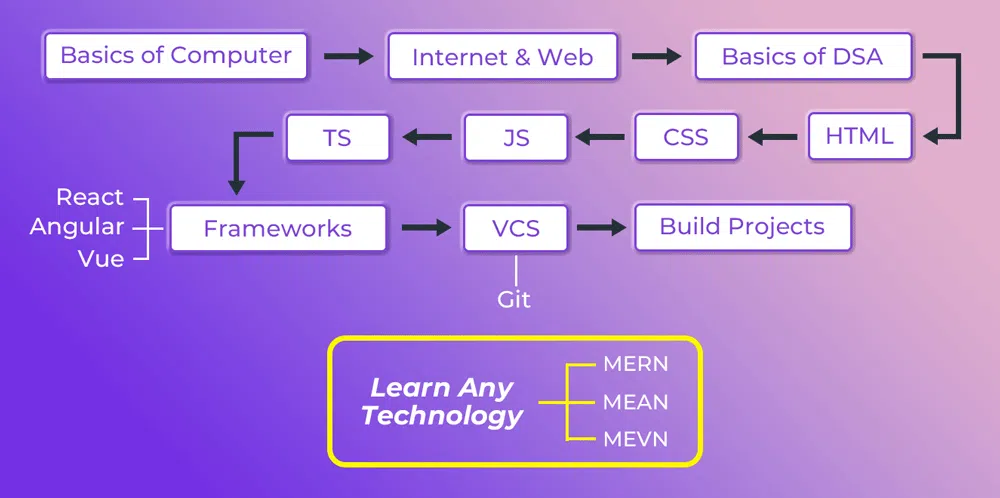

Frontend Developer Roadmap 2023
source link: https://www.geeksforgeeks.org/frontend-developer-roadmap/
Go to the source link to view the article. You can view the picture content, updated content and better typesetting reading experience. If the link is broken, please click the button below to view the snapshot at that time.
Frontend Developer Roadmap 2023
When it comes to developing a website, developers become very interested. Not only developers but even beginners who have no idea of building it, are also get amazed by the idea of building a website. Being a web developer is the most demanding and highest-paying job in India or abroad. Developers are huge in demand and so is the profession. The average pay you get as a web developer is 7-8 LPA in India. With huge pay and high demand, it is also not so difficult to become one. Though, web development has 2 integral aspects – Frontend and Backend. In this article, we’ll be particularly talking about the complete Front-End Developer Roadmap or how to make a successful career as a front-end developer.

It’s very important to know the steps of being a front-end developer since he/she implements the client side of the application through which the user communicates. Better the UI, the better the growth of the business. Hence, a front-end developer roadmap should be followed as a guide. Here are some of the most important steps you must follow in order to become a front-end developer.
Types of Developers
Developers differ work-wise, there are primarily three types of web developers. Let’s discuss each in brief.
1. FrontEnd Developer
A front-end developer is one who looks after the UI (User Interface). He/She is responsible to handle the client side of the application. Using front-end technologies, one can build the complete UI on which the user interacts. The average salary of a front-end developer is 5-6 LPA.
2. BackEnd Developer
A back-end developer is one who builds the mechanisms and manages the data. The backend is responsible for data storage, security, and communication with the UI for data transfer. It is the server-side implementation of the website. The average salary of a back-end developer is 7-8 LPA.
3. Full Stack Developer
A full-stack developer is one who maintains the client-side and server-side implementation of the website as well. He/She manages the UI, handles the data, and looks after the security of the application. The average salary of a full-stack developer is 8-9 LPA.
In this article, we’ll talk about the steps you should take in order to become a front-end developer. Also if you’re interested in back-end or full-stack, check out these articles:
Let’s begin our journey of how to become a front-end developer
Front-End Developer Roadmap

1. Basics of Computer
Before you begin your journey, you must know the basics of computers in order to have a smooth journey. To understand the basics, you must know everything about Computers. Hence, hold a strong grip on the fundamentals so that when you get on advanced topics, these small concepts should be clear.
2. Internet and Web
Also, having a clear knowledge of the working of the internet is important to know. Because of the internet and the web, these applications came into existence. therefore, without knowledge of the internet and the web, you can’t proceed.
3. Programming
For building a website, the three basic programming languages an individual must be well-versed in are HTML, CSS, and JavaScript. These are the building block of an application. Having a good command of these programming fundamentals is very much needed if you want to become a front-end developer.
A. HTML – Hyper Text Markup Language is the basic building block of web pages. You can build a single web page for the whole application using HTML. Every developer must start from the basics and reach the advanced level. And this can be achieved only by practicing your HTML skills.
Important Resource: HTML Cheat Sheet
B. CSS – Cascading Style Sheet. Not just the texts, but the presentation and usage of colors and effects make the website look engaging. This responsibility is taken care of by the CSS. This can be used in web pages to style it. When you have a strong command of CSS, you can implement a fantastic website with awesome UI. CSS Frameworks help in adding extra functionalities to the web page. There’s no doubt that BootStrap, Tailwind, and Materialize are the best CSS Frameworks for building a website but you may also check the best CSS Frameworks for Frontend Developers. The most popular CSS framework commonly used is BootStrap.
Important Resources:
C. JavaScript – After you have text and color to the website, it’s very important to make it interactive so that the user finds it interesting. JavaScript is a lightweight, open, and cross-platform programming language used by developers worldwide to build amazing websites. It can be used to build client-side and server-side websites as well. There are a few concepts that need to be clear in JavaScript to build applications.
Important Resources:
- async/await
- Best-Known JavaScript Array Methods
- TypeScript – TypeScript is a free and open-source programming language developed by Microsoft. It is used to build applications using Angular(framework) majorly.
4. Frameworks for Front-End Developer
A platform for building software applications. It includes programs, code libraries, and compilers which when brought together enable the development of a project or system. These frameworks make components reusable. The major frameworks used in front-end development are – React, Angular, Vue,etc.
- React is the JavaScript library of User Interfaces. It is build single-page applications and also allows you to create reusable UI components. It is a front-end JavaScript framework, created by Facebook in 2011. The initial version (V0.3.0) was released in July 2013. The latest version is V5.0.1. It has a size of 31.8K. This complete guide on How To Learn ReactJS: A Complete Guide For Beginners will help in making your transition towards React if you’re a beginner.
- Angular developed by Google was released in the year 2010. It is a TypeScript-based framework that uses a regular DOM. Angular provides a set of tools using which a complex, reactive UI can be built. It is primarily aimed at creating SPAs (Single Page Applications) and performs various operations such as routing, state management, PWA, testing, and building, having a size of 143K.
- Vue was developed by a former Google employee and was released in the year 2014. It was developed to make the best version of Angular and make a custom tool. It is used for developing single-page engaging and high-quality web applications. It lets you extend directives (HTML with HTML attributes) and also provides built-in directives and user-defined directives. It is the lightest framework having a size of 23K.
*Note: npmis the node package manager written in JavaScript, it lets you install all the dependencies required while building a project.
5. Version Control System
Version Control System is a platform that helps you to manage the application. Through this, you can make changes in the application such as update, edit, undo, and redo. If you’re a developer, develop a habit of using VCS which keeps a record of your application. You see, new versions of software coming now and then in the market. In this case, the previous version is stored as a file in Git (a VCS platform). It has repositories where all files including the codebase are saved and one can make changes according to the requirement. Anyone (any developer) can collaborate and make changes accordingly.
A list of Version Control Systems are
Benefits of Version Control:
- It helps you maintain code.
- You can reuse it whenever needed.
- Saves the changes made.
- Provides evidence of all changes made.
- Improves performance of web development.
- Collaborate and contribute.
Must Read – An Ultimate Guide to Git and GitHub
6. Build Projects
The best way to learn any technology or anything is when you gain practical knowledge. And this practical knowledge can be gained by building projects. While building projects, you face some real-world challenges and when you fix those, you gain extra skills which smoothen your journey as a front-end developer. Hence, building a project is much more important after you learn all the skills required to become a front-end developer. Here are the Top 10 Front-End Web Development projects For beginners you should work on.
Tech Stacks You Can Learn
- MERN (MongoDB, Express, ReactJS, NodeJS)
- MEAN (MongoDB, Express, AngularJS, NodeJS)
- MEVN (MongoDB, Express, VueJS, NodeJS)
Conclusion
A front-end developer is one who makes the website engaging using his skills with technology. Hence, it’s very important to know how to become a front-end developer. The above-mentioned points should be thoroughly followed in order to become a front-end developer. This complete guide/roadmap on front-end development will surely help you to understand each point better and when followed properly, will surely make you a front-end developer who is in huge demand.
FAQs on Front-End Developer Roadmap
1. What does a front-end developer do?
A front-end developer is one who builds the client side of the application. His/her responsibility is to build a website that has an engaging view. A front-end developer must focus on design, technology, and programming to build an efficient application.
2. What is a front-end developer’s salary?
Front-end development has become one of the most high-demanding and high-paying jobs. Therefore, the average pay in India as a front-end developer is 4.5LPA with zero experience and ranges to 15LPA+ as the experience increases.
3. What are the front-end developer skills?
The front-end developer takes care of the complete UI (for user engagement) and also works on logical-ability skills. The few most important front-end developer skills include:
- HTML
- CSS
- JavaScript
- DOM Manipulation
- Problem-Solving Ability
Recommend
About Joyk
Aggregate valuable and interesting links.
Joyk means Joy of geeK